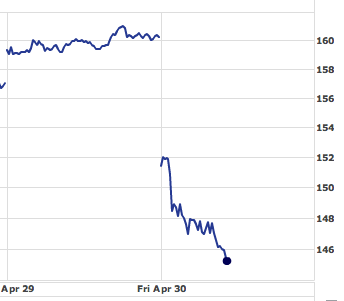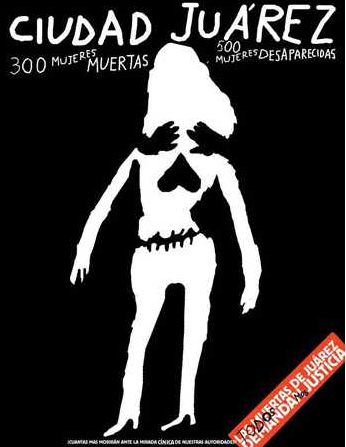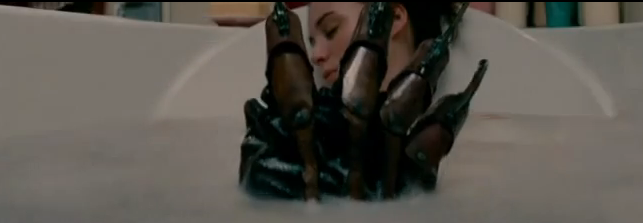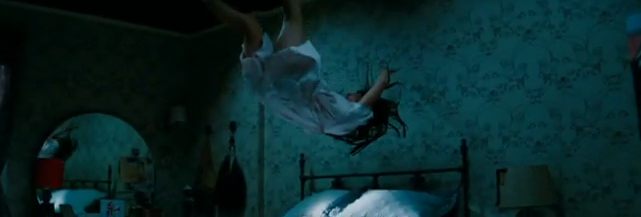Goldman Sachs Way Down On News of Everyone's Investigations Everywhere

You know how we like to make fun of finance pages for always saying “stocks are down because of [X random thing]”? Well this time, it’s true! The GS plunge started because of the SEC referral to the Justice Dept., and continued on news that the Manhattan U.S. attorney’s office has been investigating for ages. Everyone out of the pool! Everyone’s got political points to score (and maybe someone will actually come up with a case!).
Mario: The Early Years
In case you missed it, here’s the story of the Tukwila, WA real estate developer who provided the inspiration for Nintendo’s Mario character. It includes a high school year book photo.
Ciudad Juarez: Why the Press Declared a Cartel Win
by John Murray

Just a few weeks after the AP declared that the Sinaloa cartel had won the drug war in Juarez, the city saw one of its bloodiest days in recent memory. On Wednesday, 20 murders were recorded in a 24-hour span. The first murders of the day set the tone for the brutality to follow, as gunmen burst into a bar in the early morning and dragged eight people out into a nearby lot, lined them up against the wall, and executed them.
It’s something that’s become all too common, another horror story from a city where gruesome acts of violence seem to be quickly and continually supplanted by even more gruesome acts. For citizens and outsiders alike, the events themselves can tend to become indistinguishable after a while, or worse yet, almost inconsequential to the larger current of violence that had destroyed so much already. No one is ever prosecuted, and the violence just keeps on coming.
Last weekend, gunmen in SUVs swarmed two police trucks at a busy intersection and murdered six federal police officers, along with a municipal cop and a 17-year-old kid who happened to be passing by. Later in the day, a message from La Linea, the enforcement arm of the Juarez cartel, appeared scrawled on a city wall, warning that the same fate would befall all those who supported Chapo and the Sinaloa cartel. But with no real leads, and no history of people paying for these sorts of crimes, the story is already fading from the public eye.
The fact that these crimes can’t be viewed as singular events for long enough to get a hold on them before something else happens is a symbol of just how deep the culture of violence runs in the city. This larger narrative of violence that seems almost insurmountable points to the fact that Juarez isn’t merely a city with a crime problem. There is a history of impunity in Juarez that is perhaps even more sinister than the violence itself, which too often is chalked up to merely a ‘war between rival cartels,’ a definition that can be very deceptive.
Impunity in Juarez goes back a long time. In the days of Amado Carrillo, the boss of the Juarez cartel who died in 1997, unsolved murders in the city were a part of everyday life. Bodies would turn up all over the city, bound and gagged and showing signs of torture. Often they were found with a tell-tale yellow ribbon tied in bow around the victim’s head: a gift from the cartel. Few, if any, of these murders were ever solved, and most weren’t even investigated. The culprit was obvious. But he was untouchable. In addition to having most of the police on his payroll, he was Juarez’s most influential businessman at a time when the Salinas administration was bent on pushing NAFTA through. Drawing international attention to crime was far from a national priority.
The most famous example of Juarez’s culture of impunity lies in the mass femicide of the 1990s, the peak of which coincided with the peak of Carrillo’s rule in the middle part of the decade. Over the course of the decade, roughly 400 women were found murdered in the city and another 500 were reported missing and never found. The bodies that were found were usually raped. Almost all of these crimes went unsolved. The police offered up a few suspects who went to jail, but the fact is that no one person could have been behind the murders. Most speculate, based on information that has come out over the years, that the rape and murder of women was some kind of trend among men who worked for the cartel, a way to celebrate a particular operation. Essentially, they killed for kicks. This is almost impossible to wrap your head around, but for people involved in a culture of such pervasive violence, where murder is a given, life becomes very, very cheap. When people live in that culture, with access to an endless supply of money, drugs and guns, common morals as most people understand them just don’t apply, and evil flourishes.
And this is how the children of Juarez grew up, in a city where criminal figures were the real law, and murder went unpunished.
Another big part of the city’s history was the massive influx of migrant workers during the same decade. They came to work in the US-owned maquiladoras that sprung up along the Rio Grande after the passage of NAFTA. Working for pennies a day, these migrants lived in slums that developed around the city, the perfect breeding ground for gangs, drugs and the growth of the kind of seemingly hopeless street criminal culture that pervades much of what we see happening in the city today.
This is why the situation has devolved from being a simple war between two rival cartels. Now, we can barely tell who is who. Murders have been subcontracted down to gangs of 15–25 year old kids who kill for as little as $25. These same gangs also battle each other over the growing local market for drugs. Empowered with money and guns, they’ve turned to kidnappings and extortion to make more money. Armed robberies have run rampant. In Tamaulipas, the stories we hear of the drug war revolve around trucks and SUVs emblazoned with the logo of the Gulf cartel battling against other cadres of trucks full of Zetas.
But in Juarez, the most common murder stories these days are about people who couldn’t pay extortion fees, or street food vendors being gunned down for no apparent reason in broad daylight. Not to say that those things don’t happen in Tamaulipas, but they define the situation of Juarez.
When impunity is the norm, all of the criminal elements come out of the woodwork and the situation quickly gets out of control. After Calderon ordered 7,500 Mexican army troops to be stationed in Juarez in March of 2009, things quieted down for a matter of weeks, just long enough for drug money and influence to corrupt the new guard. Then the murders started up again, and actually got worse than they were before. The Army has been accused of terrifying and intimidating the public, swept up in the same free-for-all for the huge sums of money generated by drugs as the criminal elements. The most recent step was the appointment of the Mexican federal Police as the Army’s replacement, which historically is just as corrupt as any other law enforcement group in Mexico. And that is the government’s next step in their plight to save Juarez, their ‘war on the cartels.’
This perhaps is why the Associated Press ran their story preemptively declaring the Sinaloa cartel the winner in Juarez. It’s pretty near an admission of the ineffectiveness of any other force to bring a conclusion to this systemic breakdown. It’s the outcome that everyone was waiting for, even hoping for. When Amado was clearly in charge, street crime in Juarez was almost nonexistent, at least comparatively to how it is now. This was mostly because a cartel boss has an interest in keeping it that way, as part of a well-financed agreement with governmental officials to turn a blind eye to his business involved keeping the streets clean and ‘safe.’
Ultimately though, the cessation of violence isn’t something that will change the ingrained culture of violence in Juarez overnight. Until the government of Mexico starts paying attention to and valuing the people of Juarez through social programs, better education, protection of workers and by providing some measure of public safety and confidence in improvement, nothing will change. Until people start believing that the rule of law is something that can even stand up to the rule of death and violence, that it’s something that can make a difference, nothing can be accomplished.
John Murray is a lover of obscurity. He lives and writes in Arizona.
Leslie Buck, 1922-2010

The Times bids farewell to Leslie Buck, the Holocaust survivor who designed the classic Grencian-style coffee cup that stood as proxy for this city until we all went out of our minds and started shelling out five bucks a pop for coffee-style ice cream floats. Buck was 87. I am trying to think of what commonplace New York City items of today will become the go-to props when future generations want to reference our era, but all I can come up with is the MetroCard, or maybe a Foursquare badge. Sad.
Horror Chick: ‘Nightmare on Elm Street’ Isn't the 80s (But It’s Great!)
Horror Chick: ‘Nightmare on Elm Street’ Isn’t the 80s (But It’s Great!)

I’ve been getting flack for not “rating” movies. “How many stars does it get?” people ask. “Should I see it or not?” The problem with this last question is that my answer will always be “yes,” since I watch horror movies no matter how bad they are. It’s like asking a crackhead if you should spring for that double rock laced with motor oil. But since this is a big mainstream release and a lot of people are considering shelling out cash for tickets, here’s your answer: See this movie. It’s great. Now that we’ve gotten all that useful information out of the way, let’s talk about something more fun. Like Freddy. And the 80s.
So Hollywood is banking its soul on remaking 80s movies, all while relying on 1) the undying nostalgia of Olds like me who want to see our beloved childhood digitized and plastered in CGI, and 2) the total lack of taste of teenagers. One of the keys to being an 80s movie that’s remade in 2010 is the presumption that the original was, well, kind of crappy. As one article (I’d link to it, but a media insider recently sneered to me that “linking is dead,” which I hadn’t realized but I’m hardly the one who decides these things) put it, “It’s not like they’re gonna remake ‘Apocalypse Now.’” Still, for those of us who are, well, old, it’s nearly impossible to watch a remake of a 26-year-old movie and not be in a state of constant comparison-particularly when the original was a staple of our childhoods.
Which is one of the reasons the new ‘Nightmare’ is getting such a flaming on the Internet: Messing with a beloved 80’s classic can seriously backfire on you. If your audience is already supermega-nostalgic about the original, they’re gonna compare every second of your remake, frame by frame. Which is basically what I, and every other fangeek, did.
So let’s do a breakdown of the two:
The key difference, of course, is Freddy. We (meaning those of us who fully remember the 80s) adored him. He was the pre-Bart Simpson, a pockmarked iconoclast with a closet full of one-liners and no discernible morals. He represented everything our parents abhorred, and so of course we deified him beyond reason. He was the symbol of everything unsafe that lurked beneath the 80s (as well as the financial savior of New Line Cinema). His level of celebrity was Bieber-esque: A friend of mine waited in line for hours at a mall to have his ‘Nightmare’ poster signed by the man himself, who eventually wrote “Dear Adam: Go take a nap! Yours, Robert Englund.”
But in the post-innocence era of 2010, we’ve gone decidedly darker. Gone are the fluffy haircuts and pink sweater vests and beefy jock boyfriends. Today’s mainstream horror, and today’s moviegoers, are oh-so-self-aware. Nowadays we like our vodka organic, our Tolstoy digitized, and our serial killers repositories of child-raping evil. As Abe Sauer so astutely noted here, the move in this heavier-child-molesting direction began with the casting of Jackie Earle Haley, an uber-talented actor who’s hedged his career on Hollywood’s fascination with pedophiles. Despite his stature-he’d come up to Robert Englund’s shoulder, maybe-Haley summons enough twisted presence to successfully recreate Freddy as a seriously scary motherf**ker. Except in the process, he sells out the character. The New Freddy has abandoned charisma in favor of being a total Sadist-he went “Full Child-Torturing Murderer.” Yes, he’s scary, but there’s no friggin’ way anyone is waiting in line for this guy’s autograph.
Then there are the seminal scenes that made the original so amazing-the claw-in-bathtub scene, the Tina death scene, the bodybag-dragged-down-the-school-hallway scene , and of course the scene that butchered teen girl hearts, where Johnny Depp is reduced to a tanker full of blood spurting from the ceiling.
Rather than try to top these gems, the remake wisely recreates them, nearly frame by frame. Which, in my view, is a wonderful thing-my favorite moments, polished and reset in a freshly CGI-ed setting.

But the scariest aspect of today’s mainstream horror is how dark and unhappy everyone is before the killer even shows up. Gone is the fun in being young-there’s not a shred of teen sex, or even a party to take the edge off. Also gone is any innocent belief in religion (those campy crucifixes above original Tina and Nancy’s beds seem laughable now). These kids are no longer horny bee-bopping morons who must grow up to defeat a monster-now they’re seeped in self-awareness from the get-go, plodding through their white (and I mean WHITE) suburban existences in Joy Division t-shirts and Marc Jacobs boots, popping prescription meds and blogging their woes. These teens KNOW SHIT-they have knowledge of the situation almost from the beginning. And they have mothers who look maybe 4 years older than they do (“Horror in the Age of Botox” is a column for a later date).
Still, as I said before, the end product is great. Just as the original did 26 years ago, the remake delivers everything you want in a “Hey let’s go see a horror movie tonight.” The world may be a scarier place now, but we can still rely on filmmakers to show us a good time. Even if it is CGI.
Melissa Lafsky gives this 18 out of 23 somethings.
The Making of Friskies "Adventureland": "Where Do They Go In Their Minds?"
You know how we’re obsessed with the Friskies “Adventureland” cat food ads? It turns out that there is a BEHIND-THE-SCENES video about it, starring the ad exec hottie who “concepted” it, and then covers from the “script” (!) to early digital renderings to green screen cat work. Plus an interview with the cat wrangler! They explain how they get the cat to jump through the “portal”! Every minute of this is hilarious and wonderful.
Flailing Labour Party Struck By World's Most Obvious Analogy

To Britain, where beleaguered Prime Minister Gordon Brown just cannot catch a break: “The launch of a new Labour poster campaign was interrupted by a car crash close to where cabinet members were giving their speeches.” Apparently a Volkswagen Golf tried to avoid garbage truck and wound up hitting a bus shelter. In perhaps the only bit of good news the Labour party will receive during the duration of The Race To Run Knifecrime Island, “the Golf’s driver, unemployed Omed Rashid, 27, said he would be voting Labour next Thursday.” Labour strategist/Business Secretary Peter Mandelson denied that the crash was a metaphor for the party’s campaign, but that’s probably only accurate in that no one was injured and the whole thing did not end with a gigantic fireball.
Band of Horses, "NW Apt."
Here is the new video from Band of Horses, who consistently make some of the prettiest rock music available. Some of the prettiest rock music videos, too. (They like nature, which you would guess from looking at lead singer’s Ben Bridwell’s beard.) Formed in Seattle, now located in Mt. Pleasant, South Carolina, right outside Charleston (some very pretty nature there, and delicious food, too-I just visited last week!) they arrived on the national scene with impeccable timing a few years ago, right when Louisville’s My Morning Jacket stopped making some of the prettiest rock music available in favor of being more experimental, but somehow also less interesting. Band of Horses’ third album, Infinite Arms comes out May 18. You can watch them perform their new song live on the British TV show “Later Live with Jools Holland” here.
Subway Capitalizes On People Forgetting About The "And Exercise" Clause
Subway Capitalizes On People Forgetting About The “And Exercise” Clause
Sandwich chain Subway is pleased with the success of its pilot delivery program in the Washington, D.C., metro area, which ensures that you don’t even have to get up off your ever-expanding ass in order to enjoy the “healthy” “alternatives” to fast food provided by their menu. You can even order in a multi-foot-long sandwich, if you’re feeling really hungry! (Don’t worry — since it’s Subway, you can eat it all!)
St. Vincent's Hospital Manhattan, 1849-2010

“There’s a lot of heartbroken people inside the ER. … They have been the heart and soul of this hospital for many years. I think on 9/11 we saw what hatred could do. We’re seeing today what greed and politics can do to a hospital.”
–Eileen Dunn, a former nurse at the financially troubled hospital St. Vincent’s, which posted a “closed” sign on its doors and removed its signage earlier this morning. The emergency room treated 43 patients on its final night of operation; Dunn, who worked at the hospital for 24 years, is one of the 3,500 people losing their jobs as a result of the closure. [Pic via]
